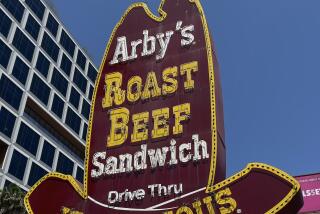The Hollywood signâs neighborhood
In 1992, the Hollywood sign was attacked by a 75-foot-tall woman.
More specifically, Paramount Pictures mounted a giant caricature of actress Kim Basinger on top of the letter âD,â paying $54,000 for the right to promote the now-forgotten movie âCool World.â The public outrage this generated, combined with the creation of the Hollywood Sign Trust to maintain the sign and guard its image, marked the end of commercial alterations of the landmark. Or so we thought.
The Hollywood sign is slated to disappear Thursday, covered with a banner that reads âSave the Peak.â The banner aims to promote a fundraising drive by the San Francisco-based Trust for Public Land to buy the adjacent 138-acre Cahuenga Peak -- the hilltop to the left of the âHâ -- and add it to Griffith Park. Unless the trust can come up with $12.5 million by April 14, the privately owned land could be sold for a luxury home development.
The Times has a little-known connection to the Hollywood sign, which was built in 1923 to promote former Publisher Harry Chandlerâs Hollywoodland housing project. So weâre tempted to go into high dudgeon when L.A.âs most internationally recognized icon -- our answer to Paris when it draped the Eiffel Tower with fireworks to celebrate the millennium on Jan. 1, 2000, was to light up the Hollywood sign -- is used for an advertisement. Would they put up a billboard on the Statue of Liberty? But then it occurs to us that a giant billboard is simply being covered by a giant billboard, the irony of it all gives us a headache, and we have to sip a soothing cup of tea until it passes.
Itâs hard to escape the conclusion that outdoor advertising has gone too far in Los Angeles, a city whose billboard moratorium is a running joke as politicians carve out exemption after exemption for individual companies. Sacramento, too, sees dollar signs in outdoor signs; Gov. Arnold Schwarzenegger has proposed leasing overhead freeway displays to advertising companies to turn them into video billboards as a way of balancing the state budget.
We donât have a clue where all this will end. But, on the other hand, we canât think of a worthier use of the Hollywood signâs marketing power than the Trust for Public Landâs fundraising drive, which would head off a housing development that would permanently mar the view of the iconic sign and the world-famous silhouette of the hills that frame it. Moreover, the peak and its glorious 360-degree vistas would be a lasting gift to the people of L.A. So weâll forgive the Hollywood Sign Trust for giving permission for the âSave the Peakâ ad -- as long as it doesnât make a habit of this sort of thing.


